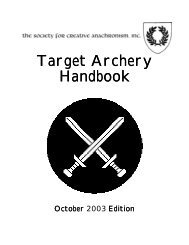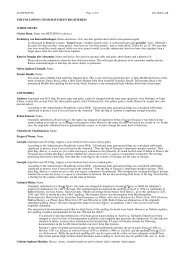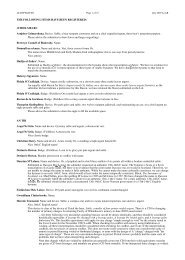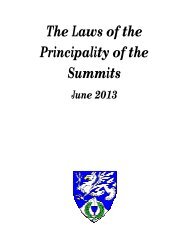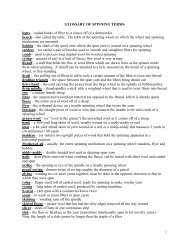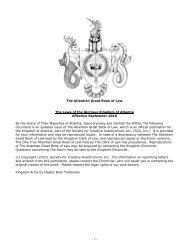Appendix B: Types <strong>of</strong> Bynames<strong>The</strong> <strong>St<strong>and</strong>ards</strong> <strong>for</strong> <strong>Evaluation</strong> <strong>of</strong> <strong>Names</strong> <strong>and</strong> <strong>Armory</strong>:<strong>The</strong> Rules <strong>for</strong> SubmissionsA byname is a name phrase added to a given name to specify which William or Mary you're discussing. Bynames fall intoseveral categories, discussed below. For a list <strong>of</strong> the types <strong>of</strong> bynames are available in various languages, see Appendix A.A. Bynames <strong>of</strong> relationship: A byname <strong>of</strong> relationship describes an individual as someone's child or describes some otherimportant relationship. Patronymic names are found widely; other types <strong>of</strong> bynames <strong>of</strong> relationship are far more limitedin their use.1. Patronymic bynames describe someone as their father's son or daughter; they are the most common <strong>and</strong> broadly foundtype <strong>of</strong> byname <strong>of</strong> relationship.Examples include the English Johnson, Williams <strong>and</strong> Robert, the Spanish Perez, the Gaelic mac Néill <strong>and</strong> ingheanDomhnaill, the Scots Makdowall, the Arabic ibn Sulaymān, the German Hainrich, the Italian di Antonio <strong>and</strong> the OldNorse Bjarnarson.2. Historical ancestor bynames describe someone as the descendent <strong>of</strong> their gr<strong>and</strong>father or earlier ancestors: the Gaelic ÓRuairc, inghean Uí Bhriain, <strong>and</strong> the Arabic al-Ḥasanī 'descendant <strong>of</strong> Ḥasan.'Others do the same thing by listing multiple generations: the Gaelic mac Conchobair mhic Fhearchair, the Welsh apRis ap Madoc, <strong>and</strong> the Norse Ketils son Gríms sonar.3. Matronymic bynames describe someone as their mother's son or daughter; these are far less common than patronymicbynames. In Engl<strong>and</strong> they are relatively common, while in Arabic <strong>and</strong> German, they are quite rare. In otherlanguages, they do not happen at all.Examples include: the English Maddison 'Maud's son', filia Agnetis 'daughter <strong>of</strong> Agnes' <strong>and</strong> Rosedoghter; the ArabicIbn Fatimah <strong>and</strong> Ibn al-Labanah 'daughter <strong>of</strong> the milkmaid'; the German Katerinen son; <strong>and</strong> the Italian di Maddalena.4. Other bynames <strong>of</strong> relationship are found only in very limited times <strong>and</strong> places. <strong>The</strong>y include the following:a. Marital bynames describe a woman as her husb<strong>and</strong>'s wife. In most cultures in period, women did not change theirbynames upon marriage (especially bynames <strong>of</strong> relationship: your father doesn't change when you get married).Examples include the Old Norse Végauts kona, the English Jackewyf <strong>and</strong> Hobsonwyf, <strong>and</strong> the Gaelic bean Cormaic.Sometimes marital bynames are identical in <strong>for</strong>m to patronymics like the Italian di Giovanni or German Dieterlins.b. Kunyas are Arabic bynames that describes someone as the parent <strong>of</strong> a child, most frequently their eldest son.Examples include Umm Badr, Abū al-Jafnā 'father <strong>of</strong> the curly haired girl', <strong>and</strong> Abū 'l-Barakāt 'father <strong>of</strong> blessings'.c. Other bynames <strong>of</strong> relationship: Occasionally, someone will be described in terms <strong>of</strong> another relationship. Examplesinclude: English Parsonbrother, Robertstepson, Parsoncosyn, <strong>and</strong> Vikersister. A few Arabic examples have verycomplex descriptions like Ibn ukht Ibn Abi ‘Uqba 'son <strong>of</strong> the sister <strong>of</strong> the man who was the son <strong>of</strong> the father <strong>of</strong>‘Uqba.'d. Work relationships describe someone as someone's current or <strong>for</strong>mer servant. Examples include the EnglishMathewservant, Websterman, Gibmayden <strong>and</strong> Prestewoman as well as the Arabic mawlā Faraj 'freedman <strong>of</strong> Faraj'.B. Locative Bynames: A locative byname describes an individual in terms <strong>of</strong> a place where they were born, they have lived,or are otherwise associated with. We categorize these in two ways: in terms <strong>of</strong> the structure, which can either be aphrase such as <strong>of</strong> London or an adjective like Londoner, <strong>and</strong> in terms <strong>of</strong> whether the locative element is a specific namedplace like London or a generic toponym like Mill or Meadow. Some languages use all <strong>of</strong> these, while others use onlysome <strong>of</strong> these patterns.1. Locative Bynames from Specific Toponyms: Locative bynames are most frequently <strong>for</strong>med from the name <strong>of</strong> a townor city. Locative bynames generally use a single word, though in English there are some examples <strong>of</strong> compound (twoRules <strong>for</strong> Submissions - January, 2012
<strong>The</strong> <strong>St<strong>and</strong>ards</strong> <strong>for</strong> <strong>Evaluation</strong> <strong>of</strong> <strong>Names</strong> <strong>and</strong> <strong>Armory</strong>:<strong>The</strong> Rules <strong>for</strong> Submissionsword) placenames used in locative bynames.Most frequently these use a prepositional phrase, like de Paris, von Massenbach, or da Bologna. Sometimes thepreposition is dropped, <strong>and</strong> simply an unmodified placename is used as a byname, like York, Langenberg, orVillanova.2. Locative Bynames from Generic Topographical Features: Locative bynames are also <strong>for</strong>med from generic descriptionssuch as Broke 'brook', Vega 'meadow', or Bois 'wood'.Most <strong>of</strong> these bynames are created as a prepositional phrase like atte Broke, de la Vega, or du Bois. Sometimes thepreposition is dropped <strong>and</strong> an unmodified toponymic is used, like Castle, Molin <strong>and</strong> Serra.3. Adjectival Bynames <strong>of</strong> Location: Some bynames describe someone as being associated with a place as an adjective,like l'Alemant 'the German,' Cornyshe, Aragones, or al-Ishbilī 'the guy from Sevilla.'Some languages only use this type <strong>of</strong> locative byname (rather than types 1 & 2 above), like Arabic <strong>and</strong> Russian. InRussian, a variety <strong>of</strong> <strong>for</strong>ms are used to indicate locations, such as Novgorodets, Novgorodtsev, <strong>and</strong> Novgorodski, allmeaning 'from Novgorod.'4. Inn-sign <strong>Names</strong>: Some languages – English, French, <strong>and</strong> German – include bynames that identify people as living neara sign <strong>of</strong> the sort used <strong>for</strong> taverns as well as houses <strong>of</strong> various sorts. Examples include English atte Rose, German zumGrifen, <strong>and</strong> French aux Deux Espees or du Cat Rouge.C. Occupational Bynames: An occupational byname describes an individual in terms <strong>of</strong> an occupation, generally one thatthey hold, but sometimes one that a parent or other relative holds. <strong>The</strong>y are common in some languages. Otherlanguages, like Gaelic, Spanish, <strong>and</strong> Russian, use only a few specific occupational bynames.Most are literal occupational terms, like the English Draper or Dyer, French Boulengier, German Bauer, or SpanishGuerrero. Other occupational bynames take the names <strong>of</strong> the items that people make, sell, or work with; this are calledmetonymic bynames. Examples include the English C<strong>of</strong>fyn or the Italian Sardello 'sardine.'D. Descriptive Bynames: A descriptive byname describes an individual in terms <strong>of</strong> their mental or physical characteristics.<strong>The</strong> names are literal in nature <strong>and</strong> the sorts <strong>of</strong> descriptions another person would immediately recognize. <strong>The</strong>re<strong>for</strong>e, thesuitability <strong>of</strong> a constructed byname <strong>of</strong> this sort must be shown with attested bynames that are similar in content <strong>and</strong> level<strong>of</strong> abstraction. Examples include the Old Norse gullskeggr 'gold-beard' <strong>and</strong> the English le Proude 'the proud'.One unusual (<strong>and</strong> less literal) type <strong>of</strong> descriptive byname found in English is the "phrase name," which gives a typicalphrase the owner uses as a byname, such as Fallinthewell.E. Dictus, cognomento, <strong>and</strong> alias Bynames: Especially in earlier European names, a byname is another given name by whicha person is known. <strong>The</strong>y are generally, but not always marked by a phrase like dictus, cognomento, or alias. Both thesuitability <strong>of</strong> the phrase <strong>and</strong> the name that follows it must be demonstrated <strong>for</strong> a particular language <strong>and</strong> culture.F. Inherited Family <strong>Names</strong>: In many languages <strong>and</strong> cultures, literal bynames <strong>of</strong> the sort described in A through E above gaveway to inherited surnames over time (though in most cultures, some literal bynames continued until after 1600). Somecultures will never adopt inherited family names.Rules <strong>for</strong> Submissions - January, 2012



